Test bike lights Fenix BT-10
I present to you an overview of the Fenix BT-10 bicycle headlight and at the same time, “Introduction to Flashlight for Dummies”. Superficially examined the basic things about LED lights. Based on basic knowledge of current-voltage. There will be little specificity - I will add. I consider the questions “Which lamp is better” provocative in advance
. Unfortunately, I can not start this review with anboxing - I received the device for testing in a bag and with signs of operation. There were no batteries in the kit either. All the light available on the farm runs on 18650 lithium cells, and the headlight requires 4 AA cells. Declared support for both disposable batteries and NiMH / NiCd batteries.
Why even develop special bike lights? Is it possible to do with a simple flashlight? After all, they are now very powerful.
It is possible, but a specialized device will do its job better. The theme of proper bike lighting is very holistic in the appropriate environment. In short, the light for active skiing (we will not consider the sidelight dimensions to designate ourselves on the illuminated city bike path) should give a bright spot a few meters in front of the wheel and a strong side light so that you can see where to go in the corner. In civilized countries, the glare of oncoming drivers is normalized. Everything is simple with us, but directing a noticeable part of the world past the road is very wasteful. Tightness - of course. Rain happens when they do not wait. Life time - several hours on one set of batteries. 2-3 sets should be enough for overnight use, albeit not at maximum speed. Velofara is in a more favorable thermal regime than a manual flashlight, because it is blown by a headwind. When the diode overheats, a silicone lens becomes cloudy in a few months, or it burns itself out in clinical cases. The steering wheel mount must be reliable and convenient so that you can quickly remove it, and the headlight itself does not fall off and does not slip anywhere. It is desirable to have a mount on the head or helmet. With good headlamps in Chinese stores is stressful.
Headlights and lights can be roughly divided into weight categories by power consumption. This is 1W (3V, 300mA), 3W (3V, 1A), 10W (3V, 3A or 7V, 1.5A), heavyweight powered by lithium-ion assemblies. How much light is needed is a moot point. A lot of it does not happen, but with excess, you can not budge the suitcase with power sources. The author uses two three-watt with different beam shapes, but 2x10 W options are also quite popular. The middle lamp is powered by a single 18650 lithium-ion battery with a voltage of 3 to 4.2 V, a capacity of 2-2.5 Ah and a discharge current of 1-1.5 A. As you can see, it can no longer handle 10W without loss of efficiency and resource. He can feed a three-watt diode for up to three hours, a one-watt diode - about 10 hours. There are always weaker modes in the flashlight. They are provided by PWM modulation of the current to the diode. Typically, 20% and 50% of the maximum power consumption is obtained.
What does a flashlight consist of? From optics, diode, housing, driver, power and switch.
Optics. Its task is to take the light from the diode and direct it where it is necessary (to the road), and where it is not necessary - not to direct (into the eyes of the oncoming driver and into the sky). In this case, there should be less loss. The main types of optics are a reflector, a conventional lens, and a Fresnel lens. The Chinese mainly stamp the reflector, the lenses go to flashlights with an adjustable beam shape, the fresnel is used less often.

The reflector

lens
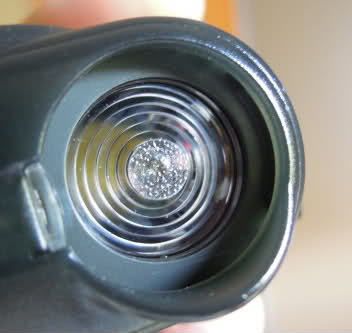
Fresnel lens
The LED in the field of bicycle lighting holds somewhere 99.5% of the market. Halogen headlights almost disappeared from the scene, xenon did not come out on it for a number of reasons. The problem is that manufacturers can recount optics after replacing a halogen lamp with an LED. The spiral of the lamp shines in all directions, and the diode shines forward with a cone. The diode requires that it be fed with a fixed or at least not exceeding the limiting current. He shines and heats up very sensitively.
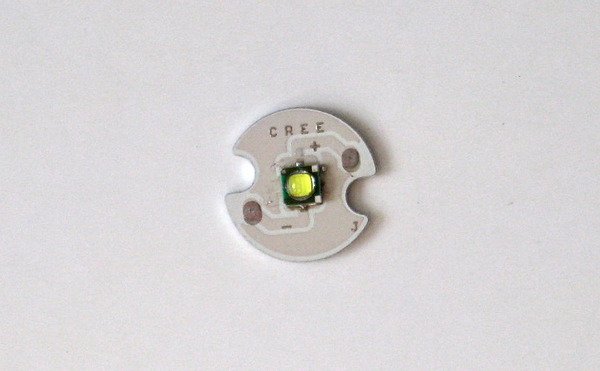
Typical diode. This is the XP-G R5, which is similar and used in this flashlight. The diameter of the substrate is around 15 mm; it is aluminum for better heat dissipation. The crystal is yellow, it is covered with a silicone drop lens.
The housing not only holds all the other parts together, but also serves as a heat sink. Brass radiators and thermal grease are widely used.
The driver must supply the same direct current to the diode. If you simply connect the diode to the battery, you will actually get a short circuit and death with the fireworks of both the diode and in the clinical cases of the battery itself. I do not consider limiting the current through the diode to the series connection of the resistor, because the last century and low efficiency. The driver also provides switching modes and indication of low battery. Usually some kind of DC voltage converter is used, or just a current source plus a PWM chip on the controller. The first option provides constant luminosity, but can kill the battery by overdischarge. The second has higher efficiency, but inconsistent brightness. In general, driver efficiency is around 90%.

Typical connection scheme. There are many options, but this is the most massive
Nutrition - see above. For small lamps this is 1 piece of 18650 or less often two series-connected halves of CR123. They give the same discharge current, but twice as much voltage and half as much capacity. For large lamps are 2x18650, also sequentially. Parallel connection is almost never used. For more power, remote powered boxes come connected to the headlamp with a thick copper wire.
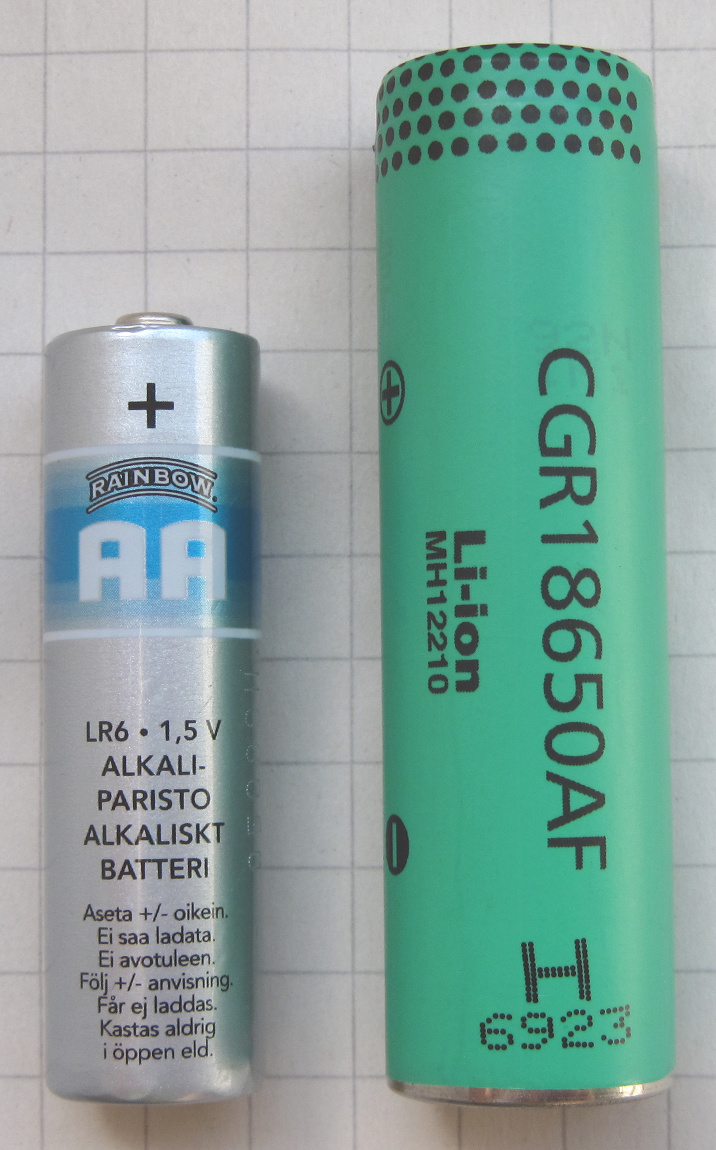
18650 against the background of a finger-type battery, it’s AA AA. The
switch is usually connected to the gap between the driver and the battery minus. So, it must pass current amperes through itself without burning contacts in the conditions of a virtual vibration bench. He also switches modes when pressed briefly.
And now let's move on to the review itself. It is sad that there is no documentation or even an advertising booklet on the spotlight, but it’s scary to climb inside.
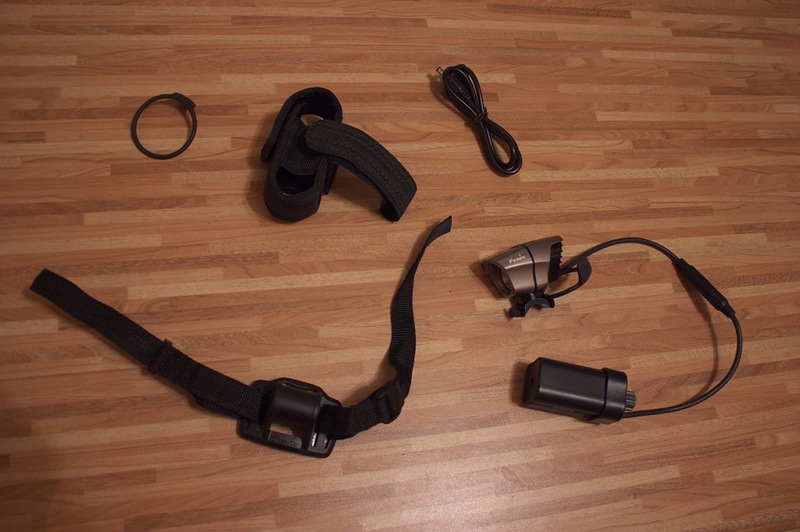
Contents of delivery. A rubber ring for fastening the headlamp to the steering wheel, waist or head cover for the power supply, extension cord, mount on the head and the lamp itself.
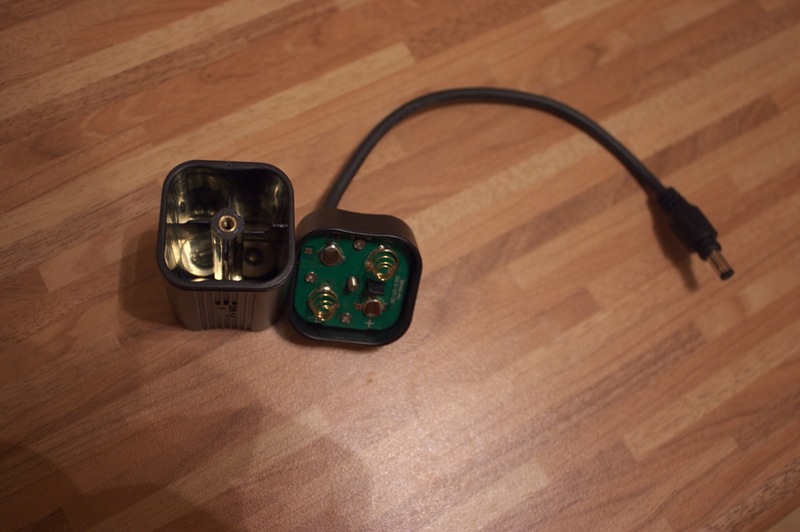
Offal of the power unit. Soldering is rarely foul, flux is not washed off. The lid boost converter to 8.4V. It does not turn off and idles even when the headlight is off, but perhaps there is some kind of energy saving scheme that is invisible to me. Raising to 8.4V was made explicitly for unification with lithium power, because the voltage exactly matches the voltage of two fully charged lithium cans. The complete batteries that were there when I got the headlamp for a test were consumed before the polarity reversal. I did not choke on 4xNiZn with a total voltage of 7.6V. The connector is standard round, waterproof. I didn’t bathe, but it looks solid and opens up with a cool “chpok” sound. Old NiMH batteries did not start at maximum speed and warmed wildly even at weak. I attribute this to great internal resistance. I couldn’t crawl with an ammeter,
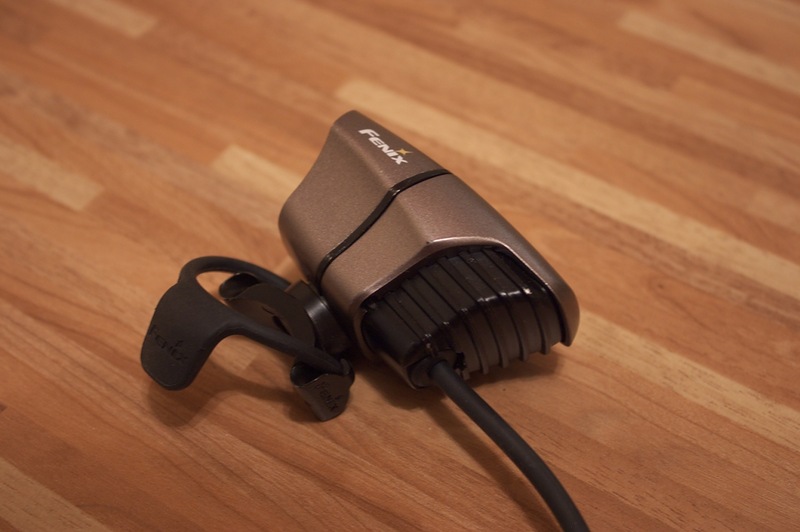
Radiator at the back. Not for furniture, it really works and heats up. The headlight itself seems to be plastic. The button on top is highlighted. Green at work and red at discharge. The steering wheel mount is quite adequate and should not be loose.
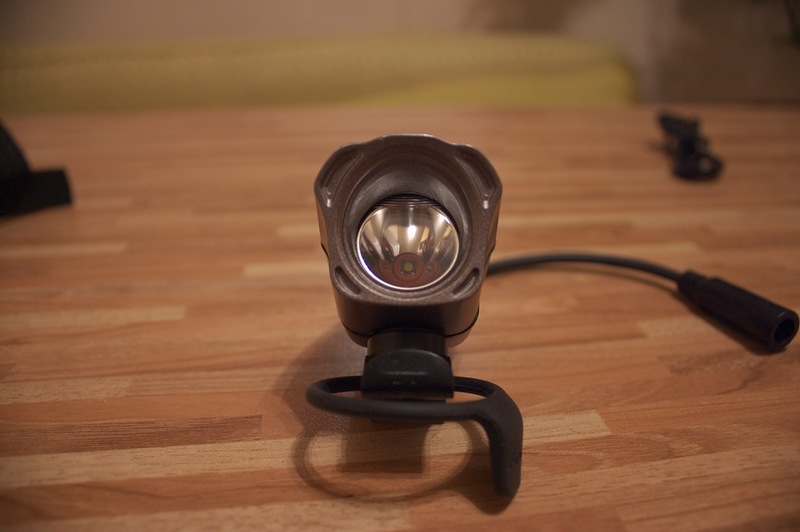
The simplest reflector with stripes. In depth a diode is most likely an XP-G R5 or equivalent.
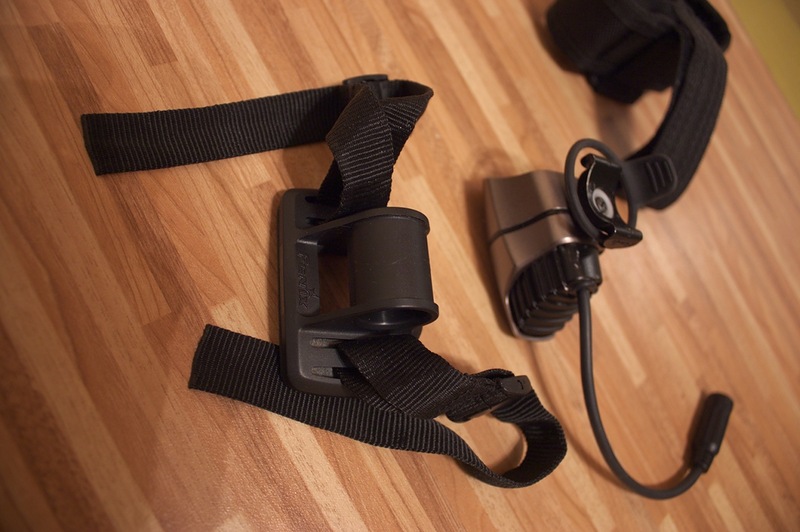
Helmet mount separately
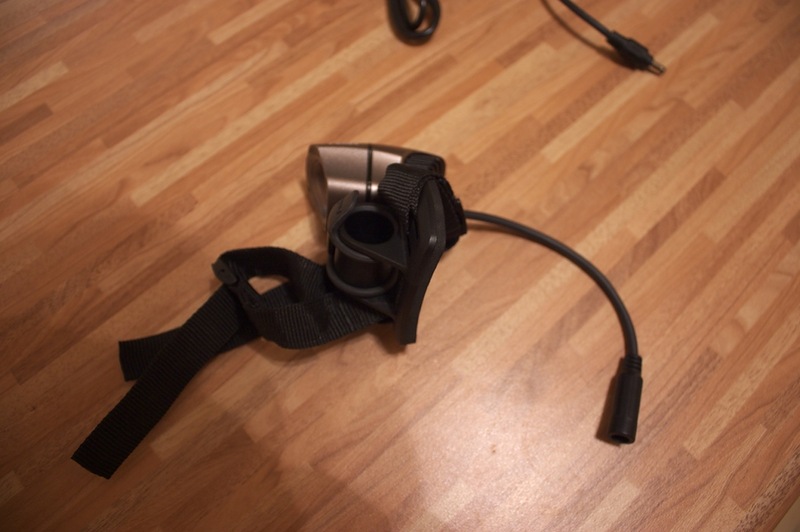
And everything is assembled. Inconvenient, because the headlight rests on the head with a hot radiator. The belts are too short and reach only the ears. Although perhaps this is a test sample bug. The helmet should sit fine.
And now the Beam shots. Shot with an antique Canon 300D, 1/10 shutter speed, aperture 3.5, 18mm, ISO3200

The most complete
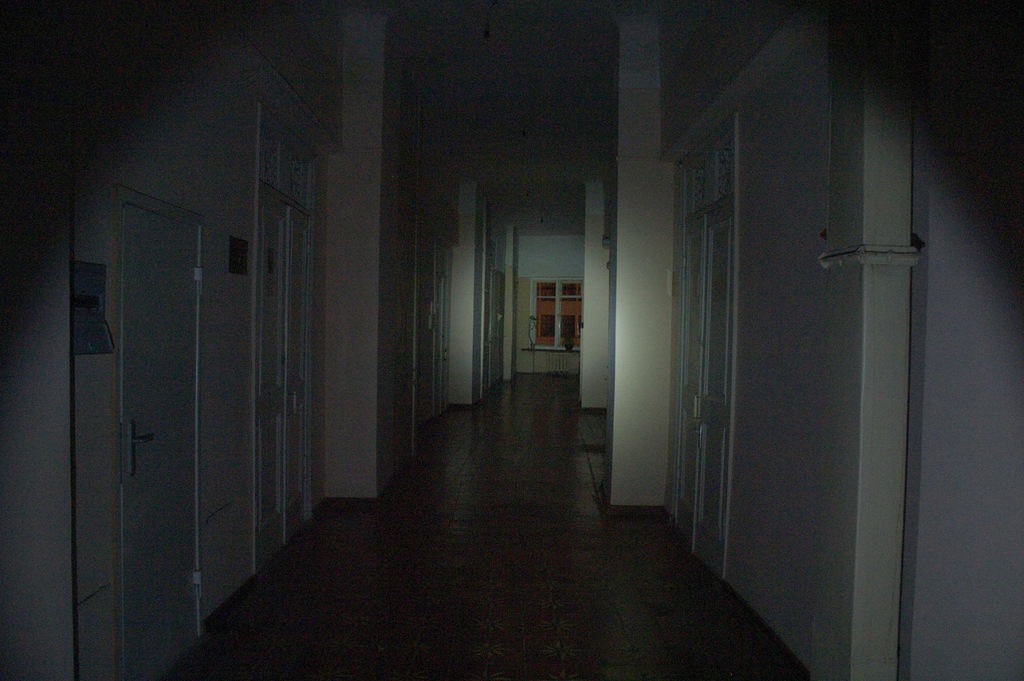
Medium
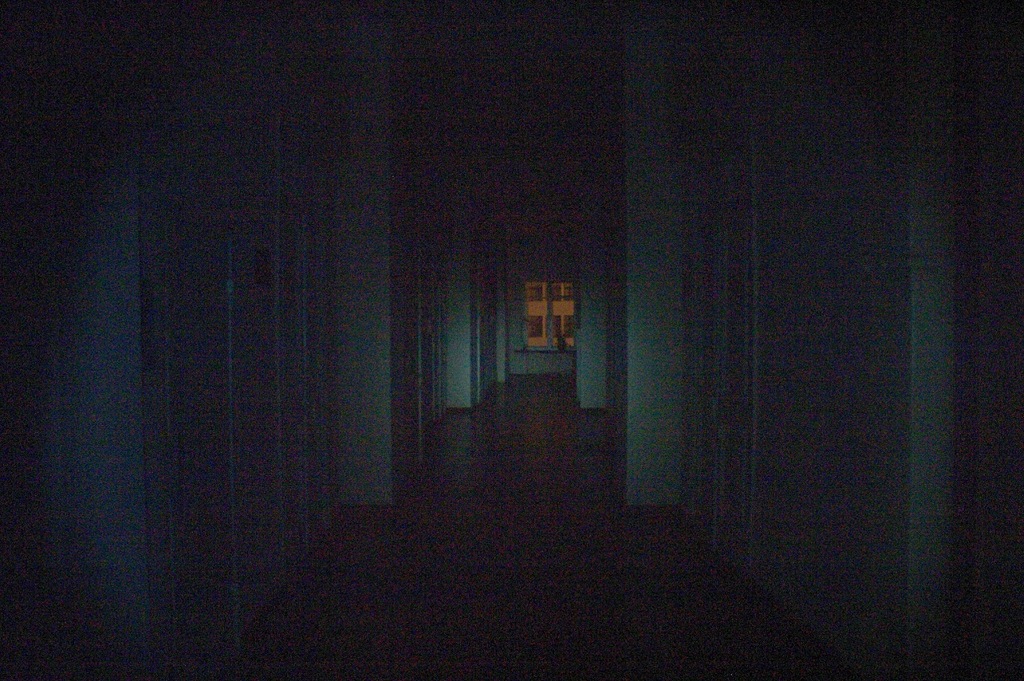
And economical mode
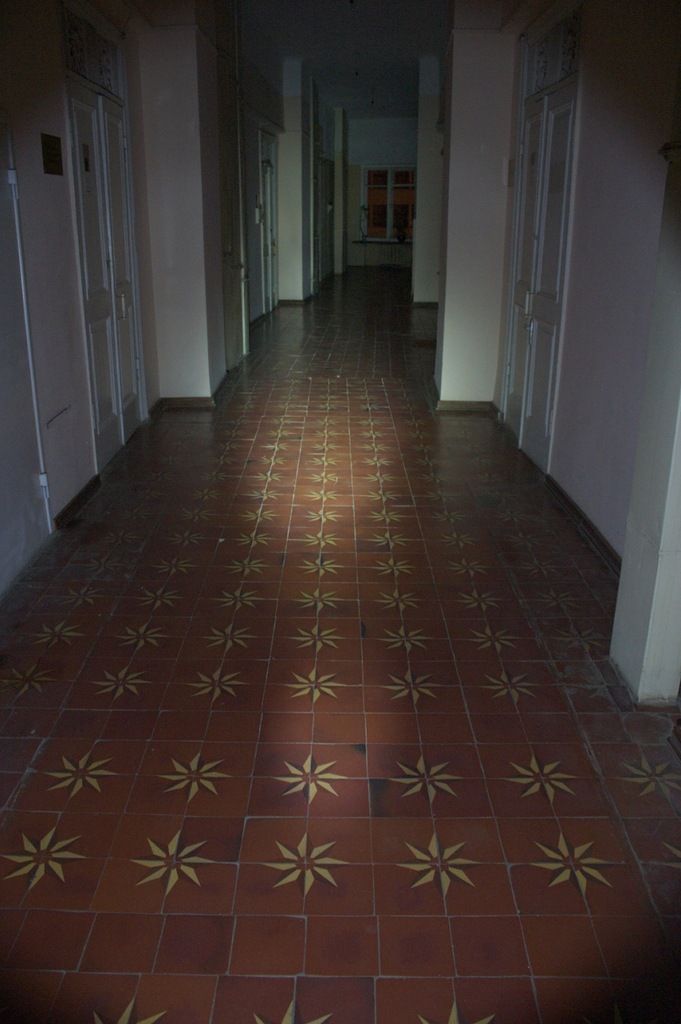
Strange shape of the beam. The bottom spot is due to the reflection of light from the visor above the glass and the scattering on those three stripes.
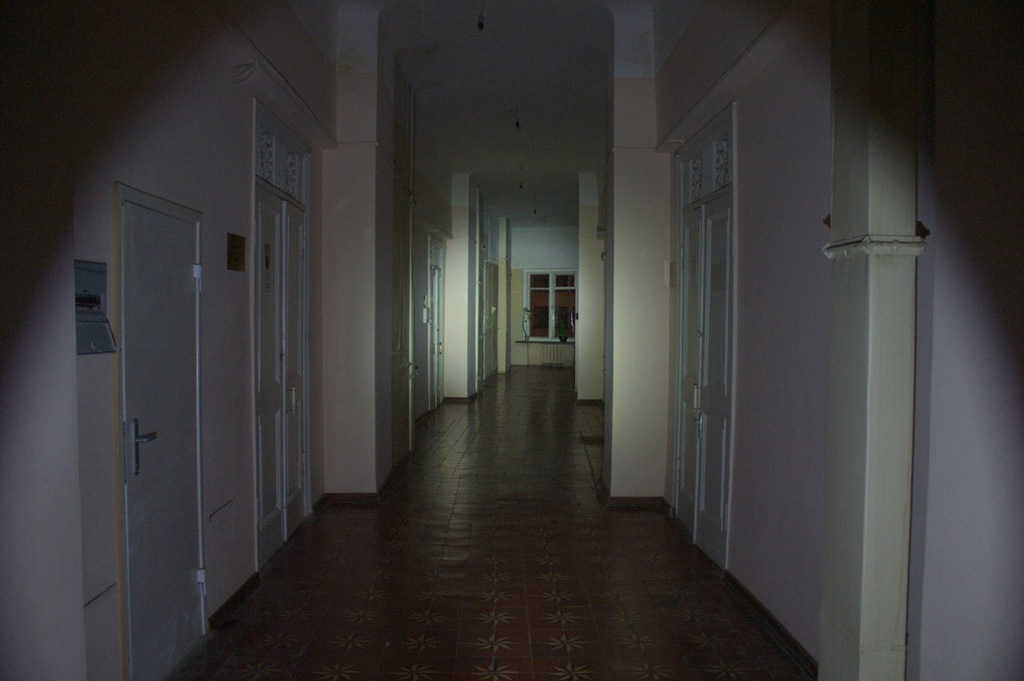
And for comparison, the Chinese are on XP-G R5. The diode runs to the limit and receives 1.05A, but you can’t drive with such a lamp - very weak side illumination. Although in the main beam a couple of things with a wide spot will fit perfectly
. Unfortunately, I can not start this review with anboxing - I received the device for testing in a bag and with signs of operation. There were no batteries in the kit either. All the light available on the farm runs on 18650 lithium cells, and the headlight requires 4 AA cells. Declared support for both disposable batteries and NiMH / NiCd batteries.
Why even develop special bike lights? Is it possible to do with a simple flashlight? After all, they are now very powerful.
It is possible, but a specialized device will do its job better. The theme of proper bike lighting is very holistic in the appropriate environment. In short, the light for active skiing (we will not consider the sidelight dimensions to designate ourselves on the illuminated city bike path) should give a bright spot a few meters in front of the wheel and a strong side light so that you can see where to go in the corner. In civilized countries, the glare of oncoming drivers is normalized. Everything is simple with us, but directing a noticeable part of the world past the road is very wasteful. Tightness - of course. Rain happens when they do not wait. Life time - several hours on one set of batteries. 2-3 sets should be enough for overnight use, albeit not at maximum speed. Velofara is in a more favorable thermal regime than a manual flashlight, because it is blown by a headwind. When the diode overheats, a silicone lens becomes cloudy in a few months, or it burns itself out in clinical cases. The steering wheel mount must be reliable and convenient so that you can quickly remove it, and the headlight itself does not fall off and does not slip anywhere. It is desirable to have a mount on the head or helmet. With good headlamps in Chinese stores is stressful.
Headlights and lights can be roughly divided into weight categories by power consumption. This is 1W (3V, 300mA), 3W (3V, 1A), 10W (3V, 3A or 7V, 1.5A), heavyweight powered by lithium-ion assemblies. How much light is needed is a moot point. A lot of it does not happen, but with excess, you can not budge the suitcase with power sources. The author uses two three-watt with different beam shapes, but 2x10 W options are also quite popular. The middle lamp is powered by a single 18650 lithium-ion battery with a voltage of 3 to 4.2 V, a capacity of 2-2.5 Ah and a discharge current of 1-1.5 A. As you can see, it can no longer handle 10W without loss of efficiency and resource. He can feed a three-watt diode for up to three hours, a one-watt diode - about 10 hours. There are always weaker modes in the flashlight. They are provided by PWM modulation of the current to the diode. Typically, 20% and 50% of the maximum power consumption is obtained.
What does a flashlight consist of? From optics, diode, housing, driver, power and switch.
Optics. Its task is to take the light from the diode and direct it where it is necessary (to the road), and where it is not necessary - not to direct (into the eyes of the oncoming driver and into the sky). In this case, there should be less loss. The main types of optics are a reflector, a conventional lens, and a Fresnel lens. The Chinese mainly stamp the reflector, the lenses go to flashlights with an adjustable beam shape, the fresnel is used less often.

The reflector

lens

Fresnel lens
The LED in the field of bicycle lighting holds somewhere 99.5% of the market. Halogen headlights almost disappeared from the scene, xenon did not come out on it for a number of reasons. The problem is that manufacturers can recount optics after replacing a halogen lamp with an LED. The spiral of the lamp shines in all directions, and the diode shines forward with a cone. The diode requires that it be fed with a fixed or at least not exceeding the limiting current. He shines and heats up very sensitively.

Typical diode. This is the XP-G R5, which is similar and used in this flashlight. The diameter of the substrate is around 15 mm; it is aluminum for better heat dissipation. The crystal is yellow, it is covered with a silicone drop lens.
The housing not only holds all the other parts together, but also serves as a heat sink. Brass radiators and thermal grease are widely used.
The driver must supply the same direct current to the diode. If you simply connect the diode to the battery, you will actually get a short circuit and death with the fireworks of both the diode and in the clinical cases of the battery itself. I do not consider limiting the current through the diode to the series connection of the resistor, because the last century and low efficiency. The driver also provides switching modes and indication of low battery. Usually some kind of DC voltage converter is used, or just a current source plus a PWM chip on the controller. The first option provides constant luminosity, but can kill the battery by overdischarge. The second has higher efficiency, but inconsistent brightness. In general, driver efficiency is around 90%.

Typical connection scheme. There are many options, but this is the most massive
Nutrition - see above. For small lamps this is 1 piece of 18650 or less often two series-connected halves of CR123. They give the same discharge current, but twice as much voltage and half as much capacity. For large lamps are 2x18650, also sequentially. Parallel connection is almost never used. For more power, remote powered boxes come connected to the headlamp with a thick copper wire.

18650 against the background of a finger-type battery, it’s AA AA. The
switch is usually connected to the gap between the driver and the battery minus. So, it must pass current amperes through itself without burning contacts in the conditions of a virtual vibration bench. He also switches modes when pressed briefly.
And now let's move on to the review itself. It is sad that there is no documentation or even an advertising booklet on the spotlight, but it’s scary to climb inside.

Contents of delivery. A rubber ring for fastening the headlamp to the steering wheel, waist or head cover for the power supply, extension cord, mount on the head and the lamp itself.

Offal of the power unit. Soldering is rarely foul, flux is not washed off. The lid boost converter to 8.4V. It does not turn off and idles even when the headlight is off, but perhaps there is some kind of energy saving scheme that is invisible to me. Raising to 8.4V was made explicitly for unification with lithium power, because the voltage exactly matches the voltage of two fully charged lithium cans. The complete batteries that were there when I got the headlamp for a test were consumed before the polarity reversal. I did not choke on 4xNiZn with a total voltage of 7.6V. The connector is standard round, waterproof. I didn’t bathe, but it looks solid and opens up with a cool “chpok” sound. Old NiMH batteries did not start at maximum speed and warmed wildly even at weak. I attribute this to great internal resistance. I couldn’t crawl with an ammeter,

Radiator at the back. Not for furniture, it really works and heats up. The headlight itself seems to be plastic. The button on top is highlighted. Green at work and red at discharge. The steering wheel mount is quite adequate and should not be loose.

The simplest reflector with stripes. In depth a diode is most likely an XP-G R5 or equivalent.

Helmet mount separately

And everything is assembled. Inconvenient, because the headlight rests on the head with a hot radiator. The belts are too short and reach only the ears. Although perhaps this is a test sample bug. The helmet should sit fine.
And now the Beam shots. Shot with an antique Canon 300D, 1/10 shutter speed, aperture 3.5, 18mm, ISO3200

The most complete

Medium

And economical mode

Strange shape of the beam. The bottom spot is due to the reflection of light from the visor above the glass and the scattering on those three stripes.

And for comparison, the Chinese are on XP-G R5. The diode runs to the limit and receives 1.05A, but you can’t drive with such a lamp - very weak side illumination. Although in the main beam a couple of things with a wide spot will fit perfectly
